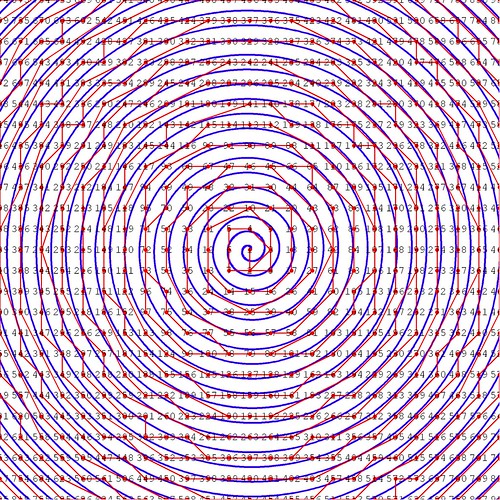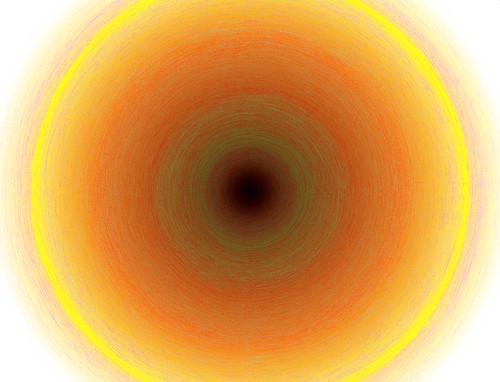Let's look at the Archimedes spiral in polar coordinates:
If we choose a = 0 and select b so that:
we can write the equations describing the spiral in Cartesian coordinates, in terms of
To get an approximation of this smooth curve on a regular grid, we can think about trying to move along it in jumps of constant length
We can rearrange this expression into something simpler:
It would be nice to solve this for
This can easily be solved for small values of
we would expect to move along the spiral, moving close to every pixel at least once. If we continue to step along the spiral like this indefinitely, and round every coordinate to the nearest integer value, we should hit every pixel in Archimedes spiral order!
This diagram shows the result of applying this algorithm:

The blue curve is a continuous Archimedes spiral, the numbered red points are the pixel approximations of the continuous curve and the red lines demonstrate the actual path taken between unique, discrete approximation points.
Below is a demonstration of what this sort of thing can look like. In this case I sorted the pixels of an original image by intensity and re-drew them along the approximate pixellated Archimedes spiral path:

The original image is here:

I've written some python code to generate these rasterized pixel spirals. You specify an image size (rectangle) and the coordinates of the spiral focus, and it generates a unique list of points lying inside that rectangle, in spiral order (as in the diagram above). It's quite fast, it can generate enough points to fill a 6 megapixel image in a couple of minutes.
from math import *
def uniquer(seq, idfun=None): # http://code.activestate.com/recipes/52560/
# Generates a unique list of elements from seq
# maintaining their original order
if idfun is None:
def idfun(x): return x
seen = {}
result = []
for item in seq:
marker = idfun(item)
if marker in seen: continue
seen[marker] = 1
result.append(item)
return result
def x(theta,alpha):
return int(round(alpha*theta*cos(theta)/(2*pi)))
def y(theta,alpha):
return int(round(alpha*theta*sin(theta)/(2*pi)))
def delta(alpha, theta, omega):
return (2*pi*omega)/sqrt(pow(alpha,2)*(1+pow(theta,2)))
def dist(a,b):
return sqrt(pow(a[0]-b[0],2)+pow(a[1]-b[1],2))
def rasterspiral(TL,BR,F):
# Distance between spiral loops
alphas=1/sqrt(2)
# Distance along spiral at each step
omegas=1/sqrt(2)
# Starting theta
thetas=0
# Define top left pixel and bottom right pixel coordinates
(tlx,tly)=TL
(brx,bry)=BR
# Spiral focus coordinates (must lie within rectangle above)
(xf,yf)=F
# Find which corner is farthest from the spiral focus
corners=[[tlx,tly],[tlx,bry],[brx,bry],[brx,tlx]]
distances=[dist([xf,yf],i) for i in corners]
farthestind=max(xrange(len(distances)), key=distances.__getitem__)
farthest=corners[farthestind]
# Initialise the spiral at F
xc,yc=xf,yf
results=[(xc,yc)]
# Keep spiralling until we've capture the farthest corner
while [xc,yc]!=farthest:
# Update the step in angle based on current angle etc.
deltanew=delta(alphas,thetas,omegas)
thetas=thetas+deltanew
# Calculate the next coordinates
xc,yc=xf+x(thetas,alphas),yf+y(thetas,alphas)
# If these coordinates lie within the defined rectangle
# then store them
if tlx<=xc<=brx and tly<=yc<=bry:
results.append((xc,yc))
# Now eliminate duplicate copies of points on the spiral
results=uniquer(results)
return results
# Example of use:
test=rasterspiral((0,0),(50,100),(25,50))
